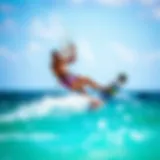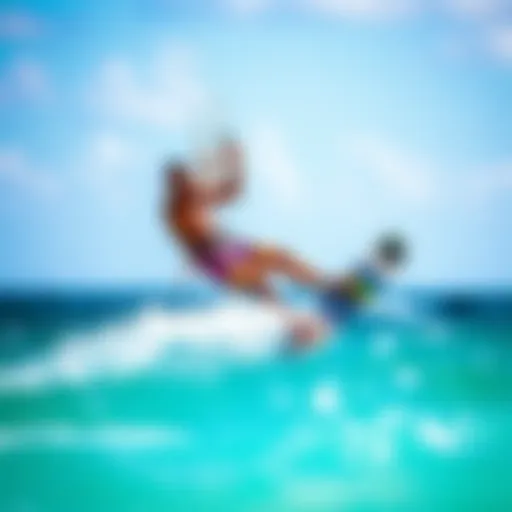Analyzing the Costs of Kiteboarding Gear
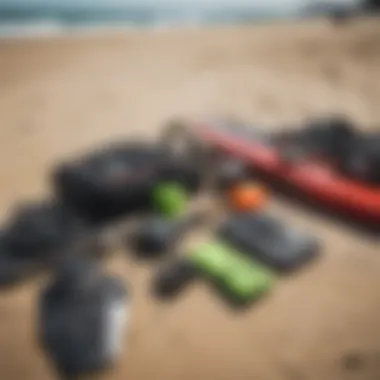

Intro
Kiteboarding is not just a thrilling outdoor activity; it's also an investment that can hit the wallet like a rogue wave. As with many sports, understanding the costs associated with kiteboarding equipment can be a maze, filled with all sorts of options and prices. Whether you’re new to the game or an experienced rider, getting to grips with what each piece of gear costs helps in planning your budget and ensuring you’re getting quality gear that matches your riding style.
From the kites themselves to the boards and harnesses, each component has its own financial intricacies. This article aims to peel back the layers of kiteboarding gear costs, providing a deep dive into what enthusiasts should expect. Understanding the differences in quality, longevity, and necessary upkeep will equip you with knowledge not just to invest wisely but also to optimize your experience on the water.
Gear Selection
Types of Kites
When it comes to kites, there’s no shortage of choices, each tailored for specific conditions and skill levels. Generally, you could categorize kites into two main types: C kites and Bow kites.
- C Kites: Known for their powerful pull, these are favored by advanced riders who love tricks and high jumps. They can cost anywhere from $800 to $1,200 depending on brands like Liquid Force or Slingshot.
- Bow Kites: These are more user-friendly and versatile, offering great steering response. They'll more likely set you back between $700 and $1,500.
Understanding the characteristics of each kite type, alongside the average costs, positions you better to match equipment to your skills and preferences. Furthermore, factors like materials, size, and even brand reputation can have a significant impact on the final price tag.
Choosing the Right Board
Just as crucial as the kite are the boards. Hopping on a poor-quality board can make the experience less enjoyable or even challenging. You typically have options between a directional board and a twin tip board:
- Directional Boards: More akin to surfing, these boards are generally preferred in waves and tend to cost about $600 to $1,000.
- Twin Tip Boards: These are the norm for most kiteboarders, allowing for easy riding in both directions. You’re looking at costs ranging from $400 to $900, based on quality and brand.
Ultimately, selecting the right board comes down to your riding style. Higher-end boards usually come with enhanced performance and durability, albeit at a steeper price.
Investing in gear that fits your skill level can make or break your kiteboarding experience.
Maintenance and Upkeep
Now that you've made your selections, remember that proper care can minimize the lifetime costs of your kiteboarding equipment. Regular cleaning and checks can prevent costly repairs down the road. Use fresh water to rinse off salt and sand after each session. Furthermore, storing your equipment properly when not in use can also vastly extend its life.
Here are a few simple maintenance practices:
- Check for any visible signs of wear and tear, particularly on the kite's leading edge.
- Regularly inspect your lines and connections, as a frayed line can lead to serious injuries.
Practicing good maintenance routines doesn’t just conserve your investment; it enhances your overall kiteboarding experience by ensuring your gear is in top shape.
This article will guide you through every aspect of costs and considerations from selecting gear to maintaining it, making sure when you hit the waves, you do so with confidence and clarity.
Foreword to Kiteboarding Equipment Costs
The Importance of Understanding Costs
Having a grasp of the financial landscape of kiteboarding equipment is crucial—especially for those just starting out. The range of products available can be overwhelming. From high-performance kites to comfortable harnesses, knowing what you’re getting—and how much it should ideally cost—can save you from common pitfalls.
When you understand the costs involved, you can better prioritize your purchases, deciding which gear is essential versus what can wait for later. Also, stepping away from guesswork means you can choose equipment that not only fits your budget but also resonates with your skill level and style—helping you to avoid wasting cash on gear that might not suit you.
Furthermore, when planning for these costs, consider that there are additional expenses that might rear their heads post-purchase, including maintenance and repairs. Understanding all these financial elements can foster a more enjoyable kiteboarding experience without the potential dread of unexpected costs down the line.
A Brief Overview of Kiteboarding Gear
Kiteboarding requires various pieces of gear that all come with their own price tags. It’s essential to get familiar with these different kinds of equipment. Here’s a quick snapshot of what you might consider when choosing your kiteboarding gear:
- Kites: The backbone of the sport, there are different types of kites that cater to different styles—from foil kites, which perform well in lighter winds, to inflatable kites, known for their versatility.
- Boards: Selecting the right board can make or break your experience. Twin-tip boards are popular for their ease of use, while directional boards offer a stylish twist for those looking to ride waves.
- Harnesses: While often overshadowed by other gear, a good harness provides the essential connection between you and your kite, ensuring comfort and control.
- Safety Gear: This includes items like impact vests and helmets, which are vital for protecting yourself while you’re shredding through the waves.
Each component plays a significant role in your overall kiteboarding experience, and the prices can vary widely, impacting your budget.
Understanding these basics helps streamline your shopping process, allowing you to allocate your funds wisely, and ultimately ensuring you’ll be geared up and ready to soar with confidence.
Types of Kiteboarding Equipment
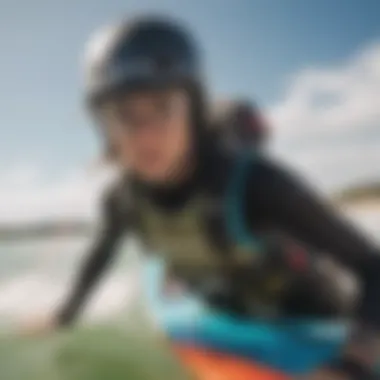

Understanding the types of kiteboarding equipment is crucial for anyone looking to dive into the sport. Each component of gear affects not only the overall cost but also your experience on the water. The right kite, board, and harness can make or break your ride. Therefore, knowing what’s available and how it fits into your budget is essential. This section will break down the different types of equipment available to kiteboarders and how each type is priced.
Kites: Varieties and Their Costs
Foil Kites
Foil kites are unique in their design, using multiple cells that can inflate or deflate with wind pressure. This design allows for greater stability and efficiency in the air. Foil kites are often favored by those who enjoy light wind conditions. They can be a beneficial option for beginner kiteboarders since they tend to be easier to handle. One downsides is that they’re not typically used in high-wind situations, which can limit their adaptability.
Additionally, they don’t pack down as small as inflatable kites, which can be a downside for transport. The cost for a good quality foil kite can range from $800 to $2,000, depending on the brand and size.
Inflatable Kites
Inflatable kites are perhaps the most commonly used type among kiteboarders. Their design includes inflatable bladders that help them maintain their shape, even when crashed into the water. This allows for a forgiving learning curve and an enjoyable experience. The key characteristic that makes inflatable kites popular is their versatility; they can be used in a variety of wind conditions without compromising performance. One particular feature to highlight is the ease of launching and landing these kites, as their design makes them more forgiving in challenging conditions. However, the price can be a bit steeper, typically ranging from $700 to $1,800, depending on the size and features.
Specific Brands and Their Pricing
When it comes to pricing for specific brands, there are several to consider. Brands like Cabrinha and Naish are well-known and tend to command a higher price against less established companies. The pricing strategies differ considerably based on brand reputation. For instance, a Cabrinha Switchblade might cost around $1,300, while a less renowned brand may offer something similar for about $800. It’s important to do your homework and understand the unique features that justify these price differences, such as warranty terms or performance specifications.
Boards: Choosing the Right One
Twin-Tip Boards
Twin-tip boards are designed for all-around riders. The feature that stands out here is their symmetrical shape, allowing riders to ride in either direction. This makes them an ideal choice for beginners, as they can practice their skills without worrying about what direction they’re facing. The cost can vary, but these boards generally range from $300 to $700, which is quite reasonable for those starting.
Directional Boards
Directional boards offer a different riding style compared to twin-tips, as they are designed to be ridden primarily in one direction. These boards tend to be favored by advanced riders who are interested in waves or freestyle. They provide better performance in specific conditions, making them a worthwhile investment for dedicated kiteboarders. Prices for directional boards often start around $400 and can reach up to $1,000 based on the materials and brand.
Cost Analysis of Different Boards
When analyzing the costs between various boards, it’s clear that the materials used for construction can significantly impact the pricing. More advanced materials like carbon fiber will drive the cost up, whereas traditional fiberglass options will be more budget-friendly. Generally, purchasing a board from a well-respected brand ensures reliability, but this comes at a premium price.
Quite often, you’ll find that spending a little extra on quality gear can save money in the long run through durability and performance.
Harnesses: Essential Comfort Gear
Types of Harnesses
Harnesses are vital to your kiteboarding experience, providing the comfort and support needed for the sport. The primary types are seat harnesses and waist harnesses. Seat harnesses tend to be preferred by beginners for their support, keeping you grounded while riding. Conversely, waist harnesses offer more freedom of movement, ideal for advanced techniques. The pricing can range from $100 for basic models to over $300 for specialized options, where superior materials and comfort are offered.
Price Ranges
Price ranges for harnesses can vary based on brand, materials, and design. A standard waist harness might cost around $150, while high-end models featuring ergonomic designs and superior padding can exceed $250. It's essential to balance comfort with budget, as a poorly fitted harness can significantly impact your kiteboarding experience over time.
Safety Gear: Prioritizing Security
Impact Vests
Impact vests play a pivotal role in ensuring safety while kiteboarding. Their primary function is to cushion the rider against impacts, which can save from nasty falls. Most impact vests are designed with buoyancy, providing extra security during use. They come in various designs and styles, which can affect the price. Generally, expect to pay anywhere from $80 to $200 for a high-quality impact vest, depending on the brand and features.
Helmets
While perhaps not the first piece of gear you think of, helmets are vital for protecting your head against unforeseen accidents. Modern helmets are designed for comfort and fit, often featuring adjustable straps for a secure fit. They can generally be purchased for anywhere from $50 to $150. The investment in a decent helmet is worth it when considering the potential risks associated with kiteboarding.
"Investing in quality safety gear is not just about comfort; it's about giving yourself the freedom to enjoy kiteboarding to the fullest."
Factors Influencing Equipment Costs
When it comes to getting into kiteboarding, understanding the costs associated with the equipment isn't just about looking at price tags. The nuances of equipment costs involve several interrelated elements that can dictate your spending and ultimately shape your kiteboarding experience. Knowing what these factors are can save you money and ensure that you make better choices when shopping.
Material Quality and Durability
The materials used in kiteboarding gear weigh heavily on its cost. Generally, equipment made from high-quality materials tends to be pricier. Take kites, for example; those crafted from ripstop nylon or polyester are typically more durable than those made from standard materials. This quality not only influences the initial cost but also impacts how long you can expect that gear to last.


Most kiteboarders would agree that investing in more durable options reduces long-term expenses. We can think about it like this: if you buy a cheaper board expecting to save money now, you may find yourself shelling out more in repairs—or worse, having to replace it sooner than expected.
A pro tip? Look for gear that comes with warranties. A warranty can indicate that the manufacturer has a level of confidence in the material used.
Brand Reputation and Pricing Strategies
Brand reputation plays a significant role in determining equipment prices in the kiteboarding market. Well-known brands like Cabrinha and Duotone often come with a higher price point, often justified by their established track records for quality and performance. These brands usually invest in research and development, leading to innovative products that can improve a kiteboarder’s experience.
Moreover, pricing strategies differ across brands. Some may set higher prices as a part of their premium branding, while others might use competitive pricing to attract a broader audience. The catch is that lower prices don't always guarantee quality, and higher prices don't assure that buyers are getting the best gear. It's often a balancing act.
"Brand loyalty in kiteboarding often results from the positive experiences shared within the community."
So, how to navigate these waters? It's advisable to read reviews, seek advice from experienced kiteboarders, and even try out different brands before committing.
New vs. Used Equipment Costs
When considering budgetary constraints, the choice between new or used kiteboarding equipment comes into play. New gear provides the latest innovations and brand guarantees, but it comes with a hefty price tag. You might find that new kites and boards can cost hundreds or even thousands of dollars.
On the flip side, the used market offers some good bargains, often with prices slashed significantly. However, this route requires due diligence. Inspect the equipment thoroughly for any signs of wear and tear. You wouldn't want to buy something that looks good on the outside but has issues that compromise your safety or performance.
Additionally, even if you find a great deal used, it’s crucial to determine how much life is left in that gear. A well-maintained second-hand kite can provide an excellent value if it’s still in good condition; otherwise, you might be putting yourself at risk or facing higher costs for repairs.
In summary, whether you’re opting for new or used equipment, the choice boils down to what fits your needs and budget. Familiarizing yourself with the different factors influencing equipment costs gives you leverage, allowing for more informed purchasing decisions that align with both your passion for kiteboarding and your financial situation.
Budgeting for Kiteboarding Equipment
Creating a kiteboarding setup requires more than just excitement and passion for the sport; it demands a methodical approach to budgeting. Budgeting for kiteboarding equipment is a crucial aspect that can shape your experience on the water. After all, investing in gear is not a one-size-fits-all affair. You must consider your personal preferences, skill level, and, of course, your financial limitations. This section breaks down the essentials of budgeting, ensuring you don’t empty your pockets while still gearing up for an exhilarating ride.
Creating a Comprehensive Budget
When crafting a budget for kiteboarding equipment, it’s essential to start with a clear overview of potential costs. Each piece of gear can significantly influence the overall expenditure, so identifying these elements upfront is key. Here are some steps to consider:
- Research Prices: Spend some time browsing various retailers, both online and brick-and-mortar. Websites like Reddit and Facebook groups dedicated to kiteboarding can provide firsthand experiences regarding pricing.
- List Priorities: Make a list of the gear you need so you can then research prices on gear like kites, boards, harnesses, and safety equipment. Pinpointing what you find essential versus what’s just nice to have can help prevent overspending.
- Consider Hidden Costs: Beyond the upfront cost of gear, don’t forget about accessories, maintenance, and potential repair needs. This might include buying a maintenance kit or seeking professional help for damages, which can sneak up on a budget.
- Set Realistic Goals: Understand your limits, and be realistic about your budget. It’s easy to get swept up in the excitement and overlook practicalities. Setting a well-thought-out budget can be the difference between a sustainable kiteboarding journey and financial strain.
Ultimately, a comprehensive budget will act as a guiding light, leading you towards informed decisions that don’t compromise on quality or safety.
Prioritizing Essential Gear Over Accessories
In the world of kiteboarding, it’s easy to get captivated by flashy accessories and trendy gear that don’t necessarily enhance your riding experience. While it’s tempting to want everything that comes along, prioritizing essential gear is crucial.
- Focus on Function: Your primary focus should be on what will improve your performance and keep you safe. Ensure your kites and boards match your riding style and conditions you plan to face. Quality over quantity can save you both money and frustration in the long run.
- Assess Safety Needs: Avoid cutting corners here; safety gear—like helmets and impact vests—should be atop your priority list. Investing in quality safety equipment is non-negotiable because it protects you during your adventures.
- Accessories as Afterthoughts: Things like fancy decals or extra straps may be eye-catching, but often they won't significantly affect your performance. Once you've secured the essentials and stuck to your budget, you can contemplate any additional accessories that catch your eye without going broke.
By keeping your priorities straight, you ensure that each dollar spent contributes to your overall kiteboarding experience. This focused approach will manage costs effectively, allowing you to enjoy the thrill of the sport without financial regret.
"A well-planned budget allows for adventures that make memories without the burden of debt."
In summary, budgeting effectively lays the foundation for a positive kiteboarding experience. It empowers kiteboarders to make informed decisions and emphasizes the significance of prioritization in equipment selection.
Maintenance and Longevity of Equipment
Understanding the maintenance and longevity of your kiteboarding equipment is crucial. The cost of kiteboarding gear can add up significantly if not managed properly. Regular care and attention can extend the life of your gear, providing a better return on your investment. Whether you are a seasoned pro or just starting out, knowing how to take care of your equipment can mean the difference between a stellar ride and a premature trip to the repair shop.
When you meticulously maintain your gear, it not only serves its purpose longer but also enhances performance. Gear in top shape provides stability and enhances your safety on the water, which is no small matter. It’s essential for kiteboarders to recognize that each piece of equipment, from your kite to your board, deserves its own set of best practices for maintenance.
Proper Care Techniques
Taking proper care of kiteboarding gear isn't rocket science, but it does require consistent effort. Here are key techniques to help extend the life of your equipment:
- Rinse After Use: Saltwater and sand can do a number on materials like nylon and polyester. Rinsing your gear with fresh water helps prevent corrosion and deterioration.
- Drying: After rinsing, let your equipment dry in the shade. Direct sunlight can cause colors to fade and fabrics to weaken.
- Storage: Store your kite deflated, rolled, and in a dry place. Proper storage prevents creases and stress on the fabric that can lead to rips.
- Regular Inspections: Check for loose seams, tears, and wear. Addressing minor issues promptly can save you from more expensive repairs down the road.
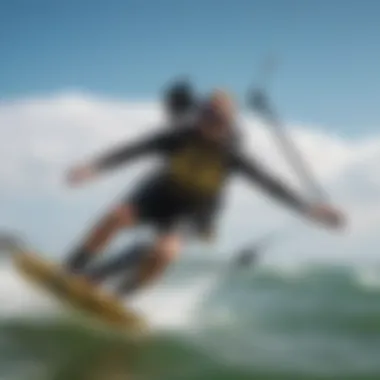

Incorporating these practices into your routine ensures that your investment in kiteboarding gear remains sound. Remember, prevention is always better than cure.
Identifying Signs of Wear and Tear
Being able to spot wear and tear early makes a world of difference. Many first-timers overlook this vital aspect, leading to strained experiences on the water. Here are signs to look out for:
- Visible Damage: Holes, snags, or lighter-colored areas on the fabric can indicate that your gear has taken a beating.
- Changes in Shape: If your kite appears heavily distorted or asymmetrical, it might not fly as efficiently as it should, affecting your performance.
- Unusual Sounds: Squeaky noises from your harness or board during use can point to problems that need attention.
"Regularly check your equipment. The sooner you identify a problem, the easier and cheaper it is to fix."
Keeping an eye on these signs not only leads to safer rides but also prolongs your equipment's life, allowing you more time on the water and less time worrying about repairs.
By investing the effort into maintaining your gear and recognizing wear, you can spend your time enjoying the wind and waves instead of lamenting over needless costs.
Seasonal Trends and Their Impact on Pricing
When purchasing kiteboarding gear, it's not just about knowing your budget and what equipment you need; timing plays a significant role in determining how much you’ll ultimately spend. The kiteboarding market often reflects seasonal patterns, which can significantly influence pricing. Understanding these trends is crucial for both new and seasoned kiteboarders, giving you the upper hand in making cost-effective buying decisions.
The kiteboarding season typically aligns with favorable weather conditions. Spring and summer mark peak kiteboarding periods in many regions, prompting higher demand which leads to elevated prices in retail shops. Alternatively, determining the off-peak periods can reveal opportunities to score some quality gear at reduced costs. Being aware of these timings not only helps in finding better prices but can also offer advantages in terms of availability of the specific types of gear you might be after.
"The best time to buy is when everyone else is selling; that’s when you can find the real gems at a discount."
When to Buy Kiteboarding Gear
Timing your purchase of kiteboarding equipment can be the difference between spending a pretty penny or saving a stack. If you can keep an eye on the trends, here are some strategic points to consider:
- Off-Season Purchases: Late fall and winter months generally see a drop in demand for kiteboarding gear. Many retailers are looking to clear out old inventory, thus slashing prices to make way for new arrivals. This can be a prime opportunity for budget-conscious buyers.
- Mid-Season Discounts: Some shops offer mid-season promotions or clearance sales. This could mean discounts on gear that’s still relevant, especially if a newer model comes out. Keeping an eye on your favorite local retailers’ promotions can yield good bargains without risking quality.
- Sales Events: Major shopping holidays often include off-peak products. Black Friday, Cyber Monday, and National Sales Days can present some fantastic deals, so plan to monitor those sales closely.
End of Season Sales and Promotions
Once the kiteboarding season comes to a close, many retailers begin their clearouts, making it a golden opportunity for the savvy shopper. End of season sales can be a time when models from the current year are marked down considerably, which can help you score fantastic equipment without breaking the bank.
Some key points to note about these end-of-season sales:
- Inventory Reduction: As shops seek to unload stock, discounts can reach up to 50% off or even more, particularly on kites or boards that will soon be replaced by the latest renditions.
- Bigger Discounts on Accessories: While boards and kites may take center stage, don’t overlook accessories like harnesses and safety gear. These also tend to be priced down significantly, allowing for budget-friendly shopping.
- Bundles and Packages: Look for package deals where multiple items are bundled together for a better price. Sometimes, shops will offer incentives or packages—including a kite, board, and harness for a combined price that's much lower than purchasing each item individually.
By being aware of the seasonal fluctuations in kiteboarding gear pricing, how it aligns with your local climate, and retail timing, you stand a stronger chance of making informed purchasing decisions that don’t strain your wallet.
Closure: Making Informed Purchase Decisions
Making informed purchase decisions is crucial in the world of kiteboarding. With an array of equipment choices and varying price tags, understanding your own needs versus what your budget allows can significantly impact your overall experience on the water. It's not just about collecting a bunch of gear; it's about finding the right tools that will enhance your skills and enjoyment of the sport.
When considering the costs associated with kiteboarding equipment, one must evaluate factors like quality, durability, and how each piece fits into your overall riding style. For instance, spending a bit more on a high-quality kite can lead to a better performance compared to a cheaper alternative that might break easily or underperform, thus costing more in the long run.
Additionally, knowing when to buy—seeking out end-of-season sales or promotions—can give you a significant edge in managing costs effectively. The goal is not just to save money, but to invest wisely, ensuring you get the most bang for your buck while still maintaining safety and enjoyment.
"Sometimes it’s not just the price tag that counts, but the value that comes with it."
Assessing Your Needs vs. Budget
Before pulling the trigger on any kiteboarding equipment, take a moment to assess what exactly you need. What type of kiteboarding do you plan to do? Freestyle? Wave riding? Or perhaps you’re just starting out and need basic gear to get your feet wet. Your riding goals will guide your equipment choices, which can be expensive if not planned properly.
Your budget is just as important. Identify how much you are willing to spend without compromising your financial stability. It is wise to set a threshold, allowing for a little wiggle room for unforeseen upgrades or replacements. Consider creating a prioritized list of needed items:
- Essential Gear: Kite, board, harness
- Safety Equipment: Helmet, impact vest
- Accessories: Pump, leash, repair kit
Understand that while high-end gear offers premium features, there are mid-range options that might suit your needs just as well, especially if you’re still learning.
Engaging with the Kiteboarding Community for Insights
Engaging with your local kiteboarding community can be incredibly beneficial. Forums on platforms such as Reddit and dedicated Facebook groups are full of experienced riders who willingly share their insights on equipment choices. Whether it's gear recommendations, tips on finding sales, or advice on maintaining your kit, communities are valuable resources.
More than just numbers, personal experiences matter. Hearing firsthand about someone’s experience with a specific kite or board can influence your decision more than any marketing claim. Networking with fellow kiteboarders can also lead you to opportunities for trading or buying second-hand gear, which can greatly reduce costs.
Don't hesitate to attend local kiteboarding events or workshops. This will not only enhance your skills but may also create connections that could lead to insights about purchasing decisions or even discounts from local shops.














